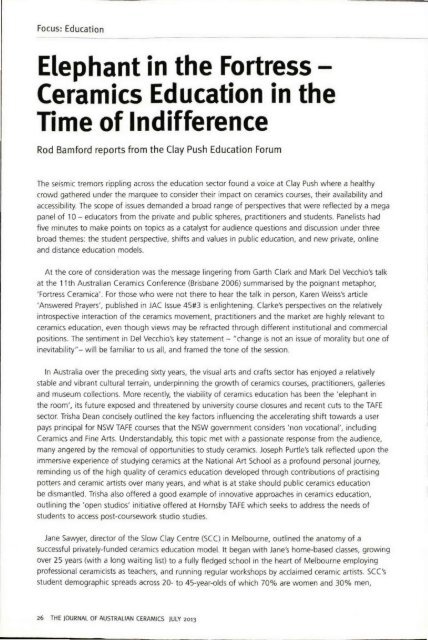The Journal of Australian Ceramics Vol 52 No 2 July 2013
Create successful ePaper yourself
Turn your PDF publications into a flip-book with our unique Google optimized e-Paper software.
Focus: Education<br />
Elephant in the Fortress -<br />
<strong>Ceramics</strong> Education in the<br />
Time <strong>of</strong> Indifference<br />
Rod Bamford reports from the Clay Push Education Forum<br />
<strong>The</strong> seismic tremors rippling across the education sector found a voice at Clay Push where a healthy<br />
crowd gathered under the marquee to consider their impact on ceramics courses, their availability and<br />
accessibility. <strong>The</strong> scope <strong>of</strong> issues demanded a broad range <strong>of</strong> perspectives that were reflected by a mega<br />
panel <strong>of</strong> 10 - educators from the private and public spheres, practitioners and students. Panelists had<br />
five minutes to make points on topics as a catalyst for audience questions and discussion under three<br />
broad themes: the student perspective, shifts and values in public education, and new private, online<br />
and distance education models.<br />
At the core <strong>of</strong> consideration was the message lingering from Garth Clark and Mark Del Vecchio's talk<br />
at the 11th <strong>Australian</strong> <strong>Ceramics</strong> Conference (Brisbane 2006) summarised by the poignant metaphor,<br />
'Fortress Ceramica'. For those who were not there to hear the talk in person, Karen Weiss's article<br />
'Answered Prayers', published in JAC Issue 45#3 is enlightening. Clarke's perspectives on the relatively<br />
introspective interaction <strong>of</strong> the ceramics movement, practitioners and the market are highly relevant to<br />
ceramics education, even though views may be refracted through different institutional and commercial<br />
positions. <strong>The</strong> sentiment in Del Vecchio's key statement - "change is not an issue <strong>of</strong> morality but one <strong>of</strong><br />
inevitability" - will be familiar to us all, and framed the tone <strong>of</strong> the session.<br />
In Australia over the preceding sixty years, the visual arts and crafts sector has enjoyed a relatively<br />
stable and vibrant cultural terrain, underpinning the growth <strong>of</strong> ceramics courses, practitioners, galleries<br />
and museum collections. More recently, the viability <strong>of</strong> ceramics education has been the 'elephant in<br />
the room', its future exposed and threatened by university course closures and recent cuts to the TAFE<br />
sector Trisha Dean concisely outlined the key factors influencing the accelerating shift towards a user<br />
pays principal for NSW TAFE courses that the NSW government considers 'non vocational', including<br />
<strong>Ceramics</strong> and Fine Arts. Understandably, this topic met with a passionate response from the audience,<br />
many angered by the removal <strong>of</strong> opportunities to study ceramics. Joseph Purtle's talk reflected upon the<br />
immersive experience <strong>of</strong> studying ceramics at the National Art School as a pr<strong>of</strong>ound personal journey,<br />
reminding us <strong>of</strong> the high quality <strong>of</strong> ceramics education developed through contributions <strong>of</strong> practising<br />
potters and ceramic artists over many years, and what is at stake should public ceramics education<br />
be dismantled. Trisha also <strong>of</strong>fered a good example <strong>of</strong> innovative approaches in ceramics education,<br />
outlining the 'open studios' initiative <strong>of</strong>fered at Hornsby TAFE which seeks to address the needs <strong>of</strong><br />
students to access post-coursework studio studies.<br />
Jane Sawyer, director <strong>of</strong> the Slow Clay Centre (SCC) in Melbourne, outlined the anatomy <strong>of</strong> a<br />
successful privately-funded ceramics education model. It began with Jane's home-based classes, growing<br />
over 25 years (with a long waiting list) to a fully fledged school in the heart <strong>of</strong> Melbourne employing<br />
pr<strong>of</strong>essional ceram icists as teachers, and running regular workshops by acclaimed ceramic artists. SCC's<br />
student demographic spreads across 20- to 45-year-olds <strong>of</strong> which 70% are women and 30% men,<br />
26 THE 10URNAL OF AUSTRALIAN CERAMICS IULY <strong>2013</strong>

















